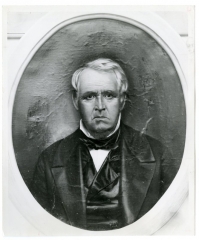Chapter VI – ADMINISTRATIVE PROBLEMS AND INCORPORATION, 1833-1846
The Board of Trustees of the Education Society faced problems in the years from 1833 to 1846 which were no less serious or perplexing than those in the period from 1817 to 1833. Often, when no solutions were apparent, the members resorted to prayer, and after they rose from their knees with uplifted spirits, the answers came to them, they reported. To lighten the burden of the local Executive Committee, which had to grapple first with the problems, the Trustees met twice each year instead of only once, as had been their custom. In 1837 the Society enlarged the Board from ten to a maximum of thirty, seven constituting a quorum.
Deacon Jonathan Olmstead presided over the Board from 1831 to 1842. No member was more conscientious. His fervent piety and deep religious faith, plus a sagacious and practical business acumen, made him a leader among his associates. If he sometimes was unduly quick to take offense they bore with him because they understood his moods and appreciated his true character. His wise counsel and generous benefactions were exceeded by no one.
Following Deacon Olmstead’s death in 1842, Seneca B. Burchard, a resident of Hamilton since the early 1820’s and a leading member of the Baptist Church, succeeded him and served until 1846. Deacon Burchard was well qualified for the office since he had been on the Board almost continuously since 1822, a member of the Executive Committee since 1826, and Treasurer from 1826 to 1837. He was a man not easily discouraged and, once he undertook a project, he was sure to complete it. His fellow Trustees counted him a valuable member of the board. Alvah Pierce, also a deacon in the village church and the son of one of the first settlers, became Treasurer in 1837; he had the distinction of remaining in office for fifty years. Systematic and frugal, he watched





